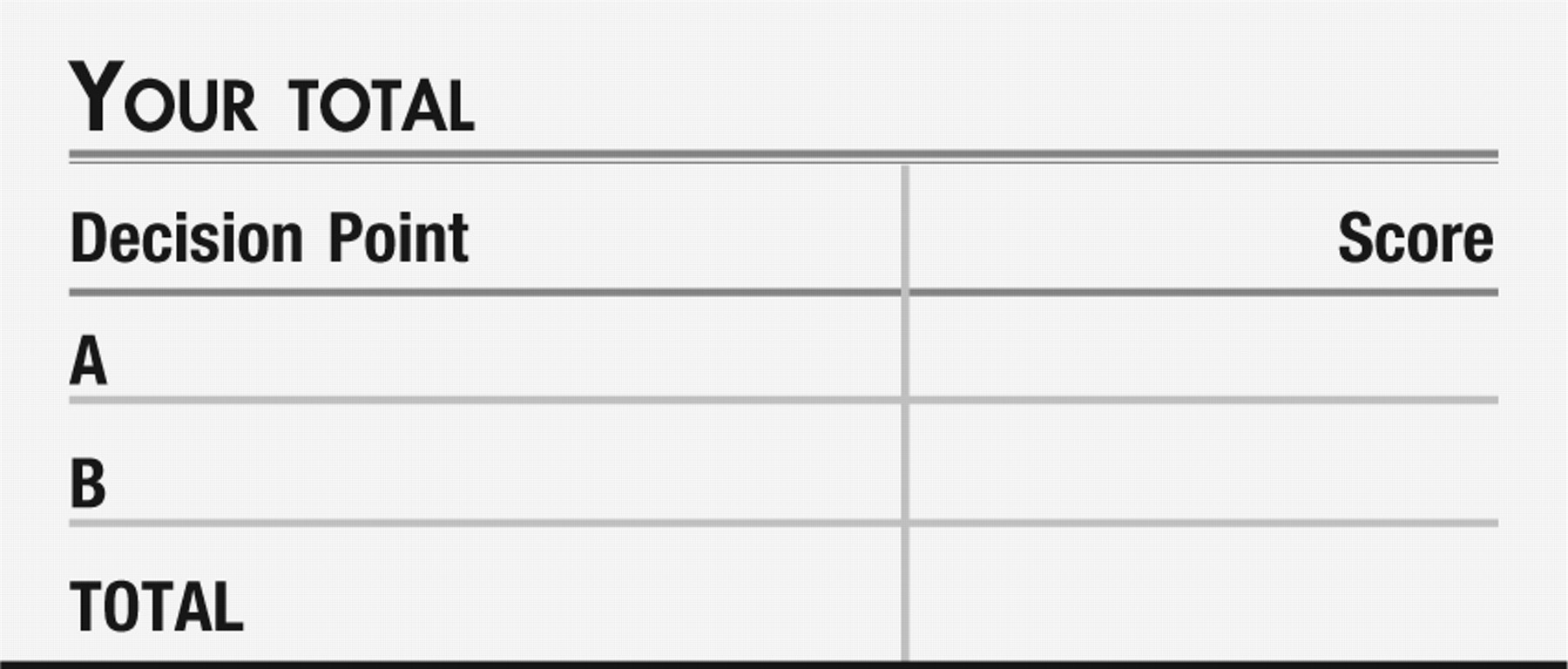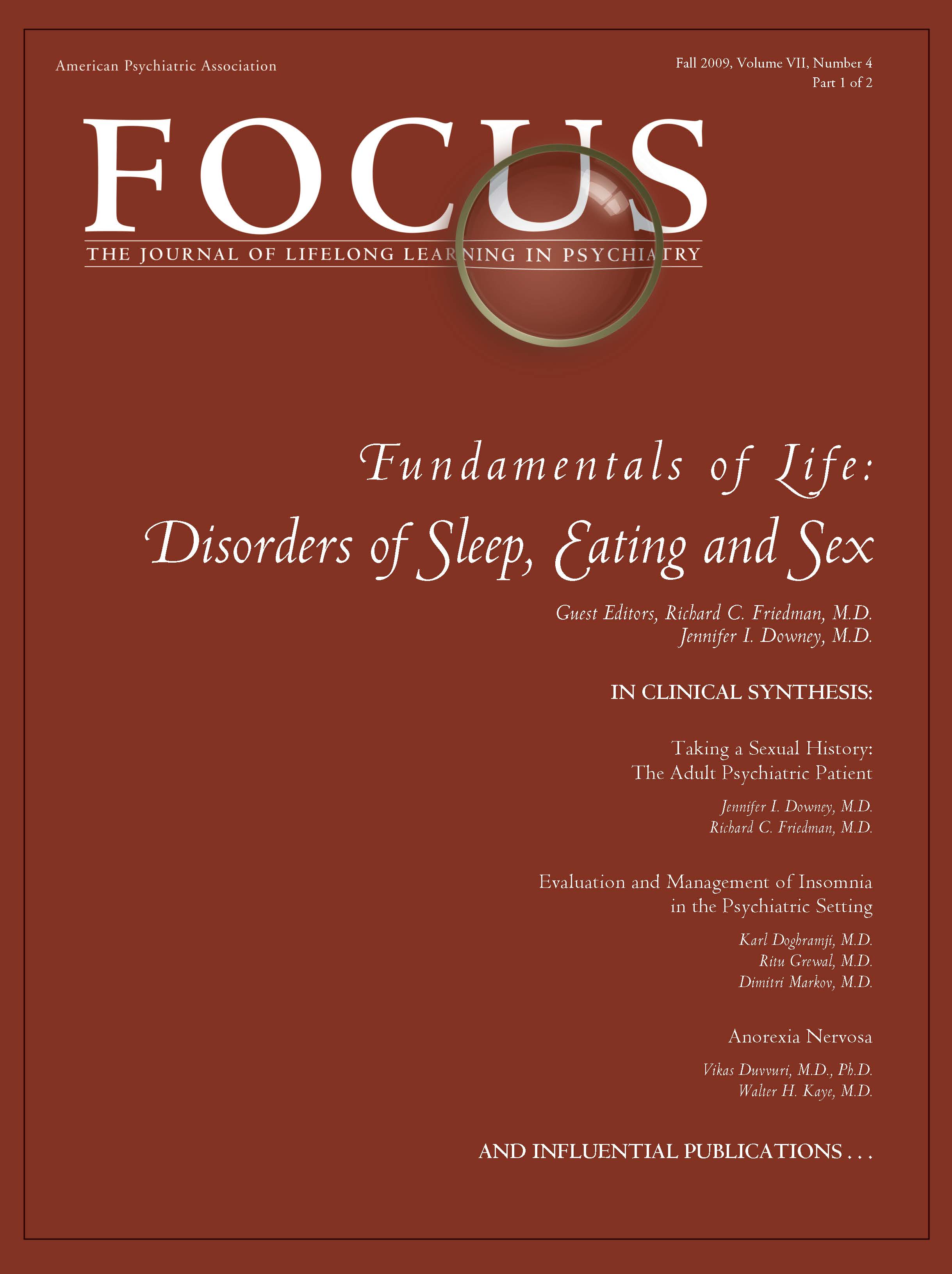Patient Management Exercise: Disorders of Sleep
Abstract
VIGNETTE PART 1
Decision Point A:
| A1._____ | Obstructive sleep apnea |
| A2._____ | Gastroesophageal reflux |
| A3._____ | Familial disturbance |
| A4._____ | Substance use related |
| A5._____ | Depression and/or an anxiety disorder |
VIGNETTE PART 2
Decision Point B:
| B1._____ | Offer a trial of an antidepressant; citalopram is covered on her formulary. |
| B2._____ | Use a higher dose of lorazepam (0.5-mg tablets): two at bedtime with an option to take one more if she is still awake 1 hour later. |
| B3._____ | Refer her for polysomnography in a sleep laboratory before changing treatment. |
| B4._____ | Defer treatment until the patient has completed 3 weeks of a nightly sleep diary. |
CONCLUSIONS
ANSWERS: SCORING, RELATIVE WEIGHTS, AND COMMENTS
Decision Point A:
| A1._____ | Obstructive sleep apnea. +1 Obstructive sleep apnea (OSA) is often linked to excess weight and increased “floppiness” in the soft tissues of the airway. Depending on the individual patient and where the weight is distributed, an extra 30 pounds might or might not be enough to lead to OSA. |
| A2._____ | Gastroesophageal reflux disease. +1 Gastroesophageal reflux disease symptoms can be related to posture and be worse at night, when lying down challenges the competence of a weakened gastroesophageal sphincter. Elevated intra-abdominal pressure from obesity can add to this issue. |
| A3._____ | Familial disturbance. +1 The patient has two small children at home. Are they sleeping through the night in their own beds? Do they awaken and try to climb into Shirley's bed? The chart does not address these issues. |
| A4._____ | Substance use related. +2 A wide variety of substances can interfere with sleep. In addition to alcohol or drugs of abuse, energy drinks can interfere with sleep if taken in the hours before bedtime. Herbal and botanical agents also can be stimulating soon after ingestion and thus should be avoided near bedtime or may be initially sedating with the potential to trigger insomnia in withdrawal states (e.g., valerian root). The chart gives no indication of whether substance use was investigated, but the widespread problem of substance use in society makes clarification worthwhile. |
| A5._____ | Depression and/or anxiety disorder. +3 Insomnia is a diagnostic component for major depressive disorder and generalized anxiety disorder in DSM-IV-TR and accounts for 3 of the 17 items of the original Hamilton Depression Rating Scale. Patients may not endorse feelings of “depression” to their PCPs for fear of being labeled “crazy” and of the issues concerning stigma and “preexisting condition” with a mental illness diagnosis in their insurance records. Not for this patient, but as a general point, the “masked depression” of elderly individuals often is characterized by anhedonia being endorsed more than depressed mood per se. The chart does not indicate either the presence or absence of rest of the 9 symptom areas of major depressive disorder. |
Decision Point B:
| B1._____ | Antidepressant treatment. +3 The patient has endorsed enough symptoms to establish the presence of a major depressive episode, apparently without any history suggestive of manic or hypomanic episodes. Anxiety symptoms are present as well and suggest comorbid generalized anxiety disorder. The patient's insurance will cover citalopram, mirtazapine, and paroxetine. Given the patient's struggles with weight, and your wish not to exacerbate any obstructive sleep apnea concerns, you elect to start citalopram at 20 mg every morning. |
| B2._____ | Address symptoms with a higher dose of lorazepam. +2 Benzodiazepines can help acutely to address the anxious ruminations that are part of Shirley's early evening insomnia. Concerns about dependency suggest that this should not be the only component of treatment, but perhaps used briefly (several weeks), for example, while waiting for a selective serotonin reuptake inhibitor (SSRI) to yield a benefit. |
| B3._____ | Polysomnography. 0 Useful diagnostic data can be obtained from a sleep polysomnographic study, including data on sleep architecture, arousals and oxygen desaturations associated with apneic periods, and restless leg syndrome. Given that this examination would be disruptive to the patient and her family and may take some time to arrange if insurance is to cover it, it may be prudent to try another empiric intervention first. |
| B4._____ | Sleep diary observations first. −2 Sleep diaries can help gather observations over several weeks and prospectively track a patient's sleep-wake patterns. Actual sleep-wake times, duration of time in bed, and day-to-day variability in sleep-wake times and other events can be observed without reliance on recall. Ongoing stressors or other events can be recorded as well, to permit an examination of any patterns. Rather than delaying treatment initiation until after these data are collected, many clinicians instead would have the patient start a sleep diary to monitor effects of a new treatment. |

REFERENCES
Information & Authors
Information
Published In
History
Authors
Funding Information
Metrics & Citations
Metrics
Citations
Export Citations
If you have the appropriate software installed, you can download article citation data to the citation manager of your choice. Simply select your manager software from the list below and click Download.
For more information or tips please see 'Downloading to a citation manager' in the Help menu.
View Options
View options
PDF/EPUB
View PDF/EPUBGet Access
Login options
Already a subscriber? Access your subscription through your login credentials or your institution for full access to this article.
Personal login Institutional Login Open Athens loginNot a subscriber?
PsychiatryOnline subscription options offer access to the DSM-5-TR® library, books, journals, CME, and patient resources. This all-in-one virtual library provides psychiatrists and mental health professionals with key resources for diagnosis, treatment, research, and professional development.
Need more help? PsychiatryOnline Customer Service may be reached by emailing [email protected] or by calling 800-368-5777 (in the U.S.) or 703-907-7322 (outside the U.S.).

